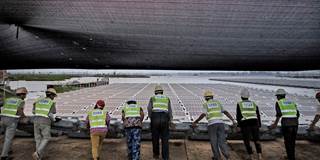The kind of large-scale, sustainable infrastructure projects needed to forestall catastrophic climate change are rarely attractive investments for the private sector or even most governments. That means development banks have a crucial role to play, so long as they put the climate first.
NEW YORK – Global financial leaders are convening in Washington, DC, this week for the annual spring meetings of the World Bank Group and the International Monetary Fund. This year, they will ask the world’s taxpayers to grant the World Bank and other multilateral development banks (MDBs) more capital to fill global infrastructure gaps.
Increasing the capital – and optimizing the existing capital – of the world’s MDBs is of the utmost importance. But doing so makes sense only if that financing is used to move the world economy in a direction consistent with the United Nations Sustainable Development Goals (SDGs) and the 2015 Paris climate agreement.
According to researchers at the Brookings Institution, the world needs to invest an additional $3 trillion per year in sustainable infrastructure in order to keep global warming below 2°C relative to pre-industrial levels – the target enshrined in both the SDGs and the Paris agreement. Today, however, infrastructure contributes heavily to global warming, with about 70% of all greenhouse-gas emissions coming from its construction and operation.

NEW YORK – Global financial leaders are convening in Washington, DC, this week for the annual spring meetings of the World Bank Group and the International Monetary Fund. This year, they will ask the world’s taxpayers to grant the World Bank and other multilateral development banks (MDBs) more capital to fill global infrastructure gaps.
Increasing the capital – and optimizing the existing capital – of the world’s MDBs is of the utmost importance. But doing so makes sense only if that financing is used to move the world economy in a direction consistent with the United Nations Sustainable Development Goals (SDGs) and the 2015 Paris climate agreement.
According to researchers at the Brookings Institution, the world needs to invest an additional $3 trillion per year in sustainable infrastructure in order to keep global warming below 2°C relative to pre-industrial levels – the target enshrined in both the SDGs and the Paris agreement. Today, however, infrastructure contributes heavily to global warming, with about 70% of all greenhouse-gas emissions coming from its construction and operation.